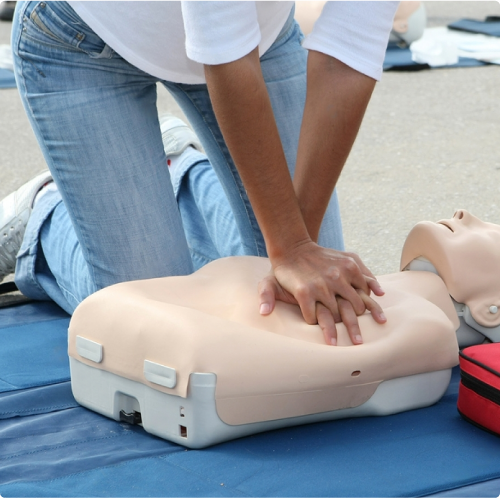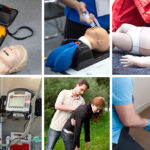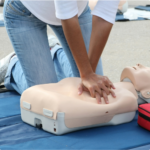
- Last Updated On: June 13, 2024
How Can You Achieve a High Chest Compression Fraction?
Imagine this: a staggering 70% of survival outcomes hinge on the quality of chest compressions administered during a cardiac emergency. We often wonder how to be really effective in cardiopulmonary resuscitation (CPR). Achieving a high chest compression fraction is essential and paves way for a successful revival. Let us explore ways how you can achieve a high chest compression fraction.
What are the techniques for effective chest compressions?
Effective chest compressions are vital in CPR to improve the chances of survival during a cardiac emergency. Explore the key techniques to perform effective chest compressions:
- Hand Placement: Place your hands on the middle of his chest, usually over half the sternum. Use the back of your hand, not your fingers, and ensure it has sufficient pressure.
- Compression Depth: In adults, compression should be at least 2 inches (5 centimeters) deep. Do not use more than necessary force to prevent injury, but deep enough for a proper chest compression.
- Compression Rate: 100–120 compressions per minute. Make the chest recoil fully between compressions and maintain a steady rhythm.
- Allowing Full Chest Recoil: Make sure that each compression allows the chest to fully return to its normal position. Insufficient chest recoil may reduce blood flow and make the compressions less effective.
- Minimizing Interruptions: Limit the number of interruptions in chest compressions to ensure that it circulates blood effectively into vital organs. Resume compressions promptly once necessary interruptions occur, such as while a defibrillator is charging or during pulse checks.
- Fatigue Management: If there is more than one rescuer available, switch positions every two minutes so as to avoid fatigue and ensure that the effectiveness of chest compression remains high.
- Consistent Technique: Ensure that the compression technique used by different CPR providers is consistent to maintain high-quality resuscitation efforts.
What are the factors influencing chest compression fraction?
Different factors may affect the chest compression fraction CCF during cardiopulmonary resuscitation CPR, determining its efficiency. These factors are crucial in determining how to best proceed with resuscitation. Here are key influencers:
1. Interruptions in Compressions: Repeated interruptions to CPR for ventilation, rhythm assessment, or any other reason can severely reduce the odds of successful resuscitation through CCF. Reducing interruptions and getting back to compressions as quickly as possible is key to achieving high CCF.
2. Quality of Compressions: Insufficient compression depth or failure to obtain full chest recoil will decrease the effectiveness of each compressive cycle and therefore impact the total CCF. Appropriate compression technique helps to maintain a high CCF.
3. Compression Rate: Deviation from the recommended CPR compression rate of 100–120 compressions per minute can affect CCF. Achieving and sustaining a high CCF demands consistency in having an appropriate compression rate.
4. Provider Fatigue: Meanwhile, prolonged resuscitation efforts may reduce the quality and rate of compressions for CPR providers. 2 minutes should rotate suppliers to avoid fatigue and maintain high CCF.
5. Team Coordination: Failure to coordinate the members of the CPR team may create poor transitions between compressors, thus making CCF less efficient. Properly coordinated teamwork ensures smooth transitions, optimizing the whole process of resuscitation.
6. CPR Training and Familiarity: If a provider has not gained enough expertise or is lacking adequate training, they may find it difficult to preserve high CCF because of the unclear technique and lack of skill confidence. The training of regular and effective CPR enhances provider confidence,which shows an effect on the CCF.
7. Equipment and Technology: Using modern CPR technologies, including real-time feedback gadgets, can improve the quality of compressions and help achieve a higher CCF. Technology integration may help providers achieve and sustain high levels of optimal compression performance.
Through training, team communication, and compliance with established CPR guidelines, addressing these factors is crucial to achieving an optimal chest compression fraction, thus paving the way for a successful revival.
What are the training strategies for improving chest compression fraction?
Enhancing chest compression fraction (CCF) through effective training is crucial for improving the overall quality of cardiopulmonary resuscitation (CPR). Here are a few training strategies that help improve chest compression fraction:
- Simulation Exercises: Practice chest compressions in a realistic scenario setting, simulating incidents of cardiac arrest. Simulations give a hands-on approach, which will enable individuals to gain confidence and proficiency in maintaining a high CCF.
- Real-time feedback devices: Train using CPR manikins with real-time feedback devices. These devices offer immediate feedback on compression depth, rate, and recoil so that learners can adjust their technique to obtain optimal high CCF.
- Team-Based Training: Focus on teamwork during CPR education. Simulate multiple providers under the consideration of seamless transfers between compressors to reduce interruptions and ensure CCF.
- Regular refreshers and drills: Organize CPR refresher courses on a regular basis to reinforce ideal chest compression techniques. Holds periodic drills to keep members active and always prepared for actual situations.
- Incorporate high-quality training materials: Make use of new and evidence-based CPR training materials that highlight the importance of achieving a high CCF. Add videos, how-to guides, and case studies to increase comprehension.
- Self-assessment and peer evaluation: Promote self-assessment by formulating instructions for people to rate their own chest compression performance. Introduce peer evaluation sessions where students can watch and give constructive criticism to each other.
- Scenario-Based Learning: Use training sessions that simulate different environments and situations in which CPR may be needed, but make them as realistic as possible. This approach facilitates participants to adjust themselves in various scenarios and acquire the competence to maintain a high CCF.
- Interactive training workshops: Carry out interactive workshops that emphasize the practical aspects of chest compressions. Use discussions, problem-solving activities, and a hands-on approach to deepen the understanding of participants about their task.
- Integration of Technology: Use virtual reality (VR) or augmented reality (AR) platforms to develop immersive CPR training scenarios. Technology can help with engagement and offer simulations that improve chest compression techniques.
- Certification Programs: Encourage the participants to register for certified CPR courses from good organizations. Certification programs make sure that individuals are well-trained and updated on achieving a good CCF.
Conclusion
Knowing how you can achieve a high chest compression fraction is not just a skill but also a potential lifesaver. Through realistic simulations, focused training, and a commitment to continuous improvement, individuals can enhance their ability to deliver effective chest compressions during critical moments. Ensuring a high CCF facilitates successful resuscitation and underscores the importance of staying updated.
Read more: Understanding CPR Compression In Depth.






